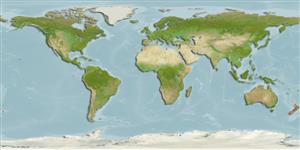Environment: milieu / climate zone / depth range / distribution range
Ecologia
marino; acqua dolce; salmastro demersale; catadromo (Ref. 51243). Subtropical; 34°S - 47°S
Southwest Pacific: endemic to New Zealand.
Length at first maturity / Size / Peso / Age
Maturity: Lm ?, range 80 - ? cm
Max length : 185 cm TL maschio/sesso non determinato; (Ref. 44724); 156.0 cm TL (female); common length : 60.0 cm TL maschio/sesso non determinato; (Ref. 9258); common length :100 cm TL (female); peso massimo pubblicato: 25.0 kg (Ref. 11115)
Commonly found in lakes and rivers (Ref. 9258). Inhabits stony rivers (Ref. 9072). Migrates to the sea to breed. Oviparous (Ref. 205). Marketed fresh, smoked and frozen; eaten fried and broiled (Ref. 9988). Reports of reaching up to 2 meters and 50 kilograms are rare and more common historically; in recent times, only a few exceed 120 cm TL (Ref. 82796).
Life cycle and mating behavior
Maturità | Riproduzione | Deposizione | Uova | Fecundity | Larve
Armitage, R.O., D.A. Payne, G.J. Lockley, H.M. Currie, R.L. Colban, B.G. Lamb and L.J. Paul (eds.), 1994. Guide book to New Zealand commercial fish species. Revised edition. New Zealand Fishing Industry Board, Wellington, New Zealand, 216 p. (Ref. 9258)
IUCN Red List Status (Ref. 130435)
Threat to humans
Harmless
Human uses
Pesca: commerciale; Acquacoltura: sperimentale
Informazioni ulteriori
BibliografiaAcquacolturaProfilo di acquacolturaVarietàGeneticaElectrophoresesEreditarietàMalattieElaborazioneNutrientsMass conversion
Strumenti
Special reports
Download XML
Fonti Internet
Estimates based on models
Preferred temperature (Ref.
123201): 10.6 - 18.3, mean 15.1 °C (based on 138 cells).
Phylogenetic diversity index (Ref.
82804): PD
50 = 0.5000 [Uniqueness, from 0.5 = low to 2.0 = high].
Bayesian length-weight: a=0.00093 (0.00076 - 0.00115), b=3.20 (3.15 - 3.25), in cm total length, based on LWR estimates for this species (Ref.
93245).
Trophic level (Ref.
69278): 4.5 ±0.5 se; based on diet studies.
Resilienza (Ref.
120179): Molto basso, tempo minimo di raddoppiamento della popolazione più di 14 anni (Tmax=60; tm=10-48 years based on age-length relationship.).
Fishing Vulnerability (Ref.
59153): Very high vulnerability (90 of 100).
